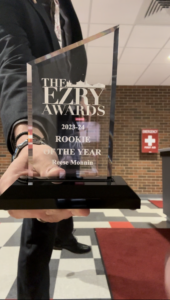This summer, the United States witnessed a revolution sustain itself through overwhelming state-sponsored violence. Protests erupted almost immediately following the murder of George Floyd committed by Minneapolis police. On May 30, in Los Angeles’ Pan Pacific Park, I joined thousands of protesters who gathered and then took to the streets. While police presence was minimal, the protest was peaceful. But after a group unaffiliated with organizers burned a police car left mysteriously unmanned, things changed dramatically.
Armed with riot gear and rubber-bullet guns, the police blocked off streets around protestors and beat unarmed men and women with batons. I saw rubber bullets fired into crowds, along with tear gas and other means of violence used. After hours of this, a violent reaction was finally provoked, turning into the looting and rioting being broadcast on television. Employing the “violent protest” narrative, the State radically escalated violence around the country. At least fifteen people have been killed by police since demonstrations began in May. Protesters, journalists, medics and bystanders have been tear gassed, pepper sprayed and shot with rubber bullets.
31 states and Washington, D.C. deployed their National Guards. In Los Angeles, soldiers guarded banks and high-end shopping malls. Nationwide, eighty localities implemented curfews, over which the American Civil Liberties Union filed suit against the City of LA, saying that it constituted an, “extraordinary suppression of all political protest in the evening hours” and that it, “plainly violates the First Amendment.” By early June, more than 10,000 protesters had been arrested and more than 140 cases of violence towards journalists had been reported by the Press Freedom Tracker.
Still, calls to “defund the police” were heard nationwide. In Seattle, Black Lives Matter called for a $100 million divestment, a 50% reduction to the budget. On Aug. 10, Seattle City Council voted to defund police by 14%. In Los Angeles, the demand is for a reduction of police spending from 54% of the budget to 1.64%. Portland City Council cut the police budget by $15 million, despite calls for a $50 million cut. In Minneapolis, nine council members proposed completely replacing the police department with a public safety department.
To maintain pressure, 24-hour protest zones popped up around the country. On June 9, the Black Future Project occupied Grand Park, by City Hall. Professors and activists were invited to educate the occupants and visitors on history and local politics. In response, the City removed public porta-potties and maintained a menacing police presence. Today, Grand Park continues to be occupied, now under the leadership of Black Unity L.A. In June, a park close to New York City’s City Hall was occupied. At 4:00 in the morning on July 22, at the direction of Mayor Bill de Blasio, police raided the encampment without warning, destroying temporary structures and people’s possessions. Many in this occupation were homeless; estimates ranged between 40% to 50%.
In Seattle, protestors took over six blocks in the police department’s East Precinct. After weeks of police brutality against them, the brother of a precinct officer drove through a group of protesters, shot a protester, and ran behind the police line, allowing himself to be arrested. Next day, police abandoned the precinct and mutual aid and activist organizations took over.
For weeks, the zone was characterized by music and free expression, but as attacks from right-wing groups grew, it became more militarized. During the day, there was political cohesion and organized protests and activities, but the homeless population within the zone grew, bringing elements of drug abuse and mental illness. Shootings and sexual assaults occurred and booths began to be dismantled. On July 1, after more than three weeks of the occupation, police raided at five in the morning, like the NYPD, destroying people’s possessions.
I got to Seattle one day after the zone was shut down, witnessing the ghostly remnants of a revolution: beautiful graffiti and murals; memorials for those lost to police violence; and a community garden. On July 4, a chapter of the Proud Boys arrived at the zone carrying guns and pepper-spraying leftists who confronted them, myself included. Six leftists, but not a single gun carrying, pepper spraying Proud Boy, got arrested that day.
In Portland this July, federal agents in unmarked cars went outside their legal jurisdiction of federal buildings, to arrest protesters at gunpoint without identifying themselves. When this was revealed Department of Homeland Security agents built a fence around the Federal Courthouse. Portland’s mayor, Ted Wheeler, attended a protest there and got tear gassed.
When I got to Portland, protestors had been in the streets more than fifty nights. Since federal troops now occupied the courthouse, nightly clashes ensued around its fence. I can testify that the violence from protesters came in response to the maliciously violent tactics of the feds. Tear gas, meant to be a dispersal method, was used to encircle protestors. After getting gassed near the gate, my group and I turned to escape, only to run into more tear gas. Pepper balls were shot without warning. Fireworks and flash bangs were fired into highly populated areas. One of my comrades got hit by something flying from a flash bang.
A group of mothers joined the resistance, placing their bodies in front of protestors so that people of color could use their voices without being threatened by State violence. Fathers with leaf blowers joined the mothers to protect them and the others from tear gas. Protesters stood their ground, firing fireworks and water bottles right back at the feds, sometimes forcing them back into the courthouse.
The shooting of Jacob Blake has reignited protests, proving the people will not yield in the face of State violence. But the State has also proven it will not yield in the face of popular uprising. In Kenosha we saw police sympathize with a white supremacist who murdered two people. In Los Angeles, on Aug. 26, police surrounded protesters firing rubber bullets and flash bangs at them. State violence and the resistance to it both lack a clear end in sight.







